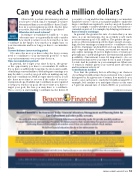Page 54 - August 2016 Newsletter
P. 54
Can you reach a million dollars?
Often in life, you have investment goals that you hope to reach. Say, for example, you have determined that you would like to have $1 mil- lion in your investment portfolio by the time you retire. But will you be able to get there? What else do I need to know?
In trying to accumulate $1 million – or any other amount – you generally should consider how much you have now, how much you can
contribute in the future, how much you might earn on your investments and how long you have to accumulate funds.
Current balance (your starting point)
Of course, the more you have today, the less you may need to contribute to your investment portfolio or earn on your investments over your time horizon.
Time (accumulation period)
In general, the longer your time horizon, the great- er the opportunity you have to accumulate $1 million. If you have a sufficiently long time horizon and a suffi- ciently large current balance, with adequate earnings you may be able to reach your goal without making any ad- ditional contributions. With a longer time horizon, you’ll also have more time to recover if the value of your in- vestments drops. If additional contributions are required to help you reach your goal, the more time you have to target your goal, the less you may have to contribute. The sooner you start making contributions, the better. If
you wait too long and the time remaining to accumulate funds becomes too short, you may be unable to make the large contributions required to reach your goal. In such a case, you might consider whether you can extend the ac- cumulation period, for example, by delaying retirement. Rate of return (earnings)
In general, the greater the rate of return that you can earn on your investments, the more likely you’ll reach your investment goal of $1 million. The greater the pro- portion of the investment portfolio that comes from earn- ings, the less earnings you may need to contribute to the portfolio. Earnings can benefit from long time horizons and compound rates of return, as returns are earned on any earlier earnings. However, higher rates of return are generally associated with greater investment risk and the possibility of investment losses. It’s important to choose investments that meet your time horizon and tolerance for risk. And be realistic in your assumptions. What rate of return is realistic given your current asset allocation and investment selection?
Contributions needed
Now that the primary factors affecting your chances of reaching $1 million have been reviewed, let’s consider this question: At a given rate of return, how much do you need to save each year to reach the $1 million target? For example, let’s assume you anticipate that you can earn a 6-percent annual rate of return (ROR) on your invest-
CONTINUED ON PAGE 54
RANDY LANDSMAN
CHICAGO LODGE 7 ■ AUGUST 2016 53
?


